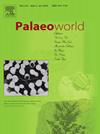New record of Brachyoxylon wood from the Lower Cretaceous of Qingyuan, southeastern China and its palaeoclimatic implications
IF 1.7
3区 地球科学
Q2 PALEONTOLOGY
引用次数: 0
Abstract
Early Cretaceous was a key period for the evolution of terrestrial ecosystems. In southeastern China, the late Early Cretaceous (Aptian–Albian) floras are relatively well known and characterized by diverse Cheirolepidiaceae, but the early Early Cretaceous floras in southeastern China are poorly known mainly because of the lack of plant fossils. Here we report petrified woods from a new early Early Cretaceous locality in Qingyuan, southern Zhejiang Province, southeastern China. The new fossil woods collected from the Xishantou Formation (earliest Berriasian, earliest Early Cretaceous) are assigned to Brachyoxylon zhejiangense Tian, Zhu, and Wang based on the anatomy of the secondary xylem. The new material of Brachyoxylon zhejiangense from Qingyuan lacks distinct growth rings or resin canals and has mixed type pitting on the radial walls of the tracheids, araucarioid cross-field pitting, and uniseriate rays. It is the earliest record of Brachyoxylon in southeastern China. Brachyoxylon zhejiangense has been regarded as the wood of the extinct conifer family Cheirolepidiceae and grew in arid to semi-arid environments. Evidence also suggests Cheirolepidiaceae played an important role in the vegetation of southeastern China throughout the Early Cretaceous.
中国东南部清远下白垩统 Brachyoxylon 木的新记录及其古气候影响
早白垩世是陆地生态系统演化的关键时期。在中国东南部,早白垩世晚期(安息-阿尔卑斯)的植物区系比较著名,其特征是多种多样的箭竹科植物,但中国东南部早白垩世早期的植物区系却鲜为人知,主要原因是缺乏植物化石。在此,我们报告了中国东南部浙江省南部庆元新发现的早白垩世植物化石。根据次生木质部的解剖结构,我们将采集自西山头地层(最早的白垩纪,最早的早白垩世)的新木化石归属于田氏、朱氏和王氏。清远的新材料缺乏明显的生长环或树脂管,在管胞的径向壁上有混合型点蚀,有raucarioid横场点蚀和单列射线。它被认为是已灭绝的针叶树科箭竹属的木材,生长在干旱到半干旱的环境中。证据还表明,在整个早白垩世,箭竹科植物在中国东南部的植被中发挥了重要作用。
本文章由计算机程序翻译,如有差异,请以英文原文为准。
求助全文
约1分钟内获得全文
求助全文
来源期刊

Palaeoworld
PALEONTOLOGY-
CiteScore
4.00
自引率
5.90%
发文量
95
期刊介绍:
Palaeoworld is a peer-reviewed quarterly journal dedicated to the study of past life and its environment. We encourage submission of original manuscripts on all aspects of palaeontology and stratigraphy, comparisons of regional and global data in time and space, and results generated by interdisciplinary investigations in related fields. Some issues will be devoted entirely to a special theme whereas others will be composed of contributed articles. Palaeoworld is dedicated to serving a broad spectrum of geoscientists and palaeobiologists as well as serving as a resource for students in fields as diverse as palaeobiology, evolutionary biology, taxonomy and phylogeny, geobiology, historical geology, and palaeoenvironment.
Palaeoworld publishes original articles in the following areas:
•Phylogeny and taxonomic studies of all fossil groups
•Biostratigraphy, chemostratigraphy, chronostratigraphy
•Palaeoecology, palaeoenvironment and global changes throughout Earth history
•Tempo and mode of biological evolution
•Biological events in Earth history (e.g., extinctions, radiations)
•Ecosystem evolution
•Geobiology and molecular palaeobiology
•Palaeontological and stratigraphic methods
•Interdisciplinary studies focusing on fossils and strata
 求助内容:
求助内容: 应助结果提醒方式:
应助结果提醒方式:


